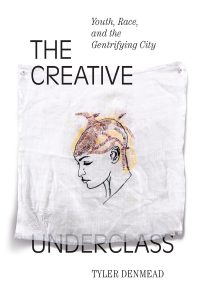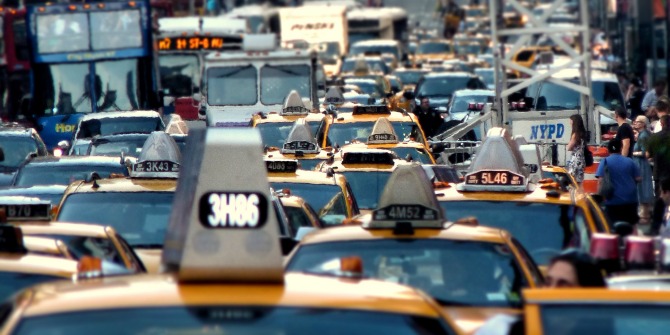In The Creative Underclass: Youth, Race and the Gentrifying City, Tyler Denmead reflects on his role in founding New Urban Arts, an arts and humanities programme primarily for young people of colour in Providence, Rhode Island, using this as a means to critically examine how well-meaning arts organisations can replicate systems of race- and class-based inequalities in the face of gentrification. By highlighting the lived experiences and creative strategies of young people living through the challenges of gentrification, the book offers a means to begin envisioning a future city that enables the creativity of all, rather than ‘creativity’ as a luxury consumer product, writes Kevin Ritter.
The Creative Underclass: Youth, Race and the Gentrifying City. Tyler Denmead. Duke University Press. 2019.
 Find this book (affiliate link):
Find this book (affiliate link): ![]()
Throughout the twenty-first century, many US and British cities followed the lead of influential urban planner Richard Florida. Florida’s 2002 book, The Rise of the Creative Class, reframed urban development strategy, encouraging a focus on growing the broadly defined ‘creative economy’. Cities, hoping to lure a young, affluent workforce with cash to burn, transformed their formerly industrial spaces into luxury apartments and micro-breweries. Florida also increased focus on the arts and cultural sector, occasionally as an economic sector in itself, but more often as an amenity that could increase property values and therefore revenues.
However, the benefits of Florida’s approach have not been spread evenly. Many post-industrial cities, like Youngstown, Ohio, and Madison, Wisconsin, have failed to see increased economic prosperity even after refashioning their downtowns to appeal to the supposed creative class. Additionally, the benefits of the creative city are usually heaped upon white, upper-class workers, and can lead to the displacement of working-class communities of colour.
Tyler Denmead’s book, The Creative Underclass: Youth, Race, and the Gentrifying City, is in many ways a refutation of the Floridian ethos. Denmead was the founder and director of New Urban Arts, a youth-oriented arts organisation located in deindustrialising Providence, Rhode Island. The book follows two lines of inquiry: first, exploring the creative practices of participants in New Urban Arts’s programming; and later untangling New Urban Arts’s complicit relationship with gentrification in Providence.
In the fifth chapter of The Creative Underclass, titled ‘Autoethnography of a ‘Gentrifying Force’, Denmead maps the ways in which New Urban Arts was deployed by city government and real estate interests as they crafted a narrative of the ‘creative city’. In 2003, Mariana, a participant in New Urban Arts, painted a mural with her peers on the corner of Dean and Westminster Streets. The mural features portraits of neighbourhood residents and Providence landmarks. Denmead suggests that while the process of researching and painting the mural was a good experience for participants, the artwork ultimately sped the gentrification process that would later displace Mariana from her home. In 2005, the mural was featured in the travel section of the New York Times, encouraging tourists to visit Mariana’s neighbourhood, highlighting a recent migration of artists seeking affordable loft spaces.
This uncomfortable relationship between art and gentrification is a well-documented phenomenon. Developers frequently weaponise art to boost property values and lend an aura of ‘authenticity’ to appeal to affluent potential residents. From Brooklyn to Miami to London, public murals and street art can speed the gentrification process. This process is often called ‘artwashing’, and many community groups have organised protests against art galleries and public art catering to upper-class white consumers. Some critiques of art and gentrification rely heavily on an ideology focused on ‘consumer choice’, and Denmead spends a good amount of the book exploring the preferred restaurants and places of Providence’s gentrifying class, especially by centring the socially complicated relationships that New Urban Arts’s participants have to these spaces.
But gentrification is also a structural process of capital accumulation for real estate developers — as well as many home-owners. In Denmead’s examples, gentrification is certainly structural: the city government granted real estate developers tax credits and created a noncontiguous historic district to spur the transformation of formerly industrial space into residential apartments. By relying on art and artists to lure wealthier renters and buyers to working-class neighbourhoods, real estate developers are able to profit more quickly — closing what Neil Smith would call the ‘rent gap‘: the difference between the current ground rent on a space and the potential, much higher rate after gentrification.
Throughout the book, Denmead foregrounds the experiences, creative practices and vocabularies of the youth participants in New Urban Arts. (The term ‘gentrifying force,’ for example, comes from a social media post by an alumni of the programme.) If Florida’s approach to urban development focused on attracting ‘creative class’ workers, Denmead’s focus here is on the ways that all workers and all people are creative, though he notes that the creative practices of the youth participants often stand in contrast to those that are valued by funders and city officials.
In his third chapter, Denmead frames ‘chillaxing’ (a term he borrows from Lunisol, a participant) as a necessary process of rest and recuperation to cope with the traumas of dealing with a racist education system and racialised poverty. The first three chapters lift up practices like ‘chillaxing’, ‘trouble-making’ and the ‘hot mess’ (in the context of New Urban Arts, Denmead and participants conceptualise a ‘hot mess’ as a sort of generative chaos). Such practices often stand in contrast or opposition to those encouraged by the education system. New Urban Arts would come into conflict with governmental agencies due to the unstructured nature of the programming — evaluators would score the programme low in categories like ‘starting on time’. Governmental funders expected New Urban Arts to ‘reform’ the youth of colour participating in its programming. But Denmead exposes a double standard: in his education as a white student in well-resourced institutions, Denmead was encouraged to explore and push boundaries, while the youth of colour in New Urban Arts’s programming do not have their creativity and curiosity cultivated in the same way by their schools.
In The Creative Underclass, Denmead spends a good amount of the book exploring his positionality, both as the founder and organiser of New Urban Arts and as an academic working on issues of education. Denmead, as a white man, has benefited from his white privilege and his class privilege. It is this privilege that allowed him to explore his interests and creativity freely as a child and undergraduate student. It is this privilege that enabled him to start a non-profit in his early twenties that was looked upon favorably by governmental and non-profit funders. It is this privilege that allows him to write books reflecting on this experience, which ultimately advances his own academic career — as he writes himself in the book. This self-reflexivity can sometimes feel like hand-wringing, but it is an important step through which Denmead positions himself not as an outside observer, but as a participant and beneficiary of racist systems.
The relationship between gentrification and culture is a fraught and complicated one, and there is no easy path. But through engaging with the creative strategies of the youth that Denmead profiles in The Creative Underclass, we might begin to envision a future city that enables the creativity of all, not ‘creativity’ as a luxury consumer product. This volume highlights the lived experiences of youth living through the challenges of gentrification. Planners and policymakers may find it to be an important corollary to more revenue-oriented visions of the ‘creative city’, exposing a deep rift between the experiences of Florida’s ‘creative class’ and Denmead’s ‘creative underclass’. Those in the education sector, too, will find its exploration of inequality valuable, especially in considering the ways that even well-meaning arts programmes can replicate systems of race- and class-based inequalities in the face of gentrification.
- This article originally appeared at the LSE Review of Books.
- Please read our comments policy before commenting.
Note: This article gives the views of the authors, and not the position of USAPP– American Politics and Policy, nor of the London School of Economics.
Shortened URL for this post: https://bit.ly/36IPeaa
About the reviewer
Kevin Ritter
Kevin Ritter is an urban planner and administrator in New York City. He holds a master’s in urban planning from Hunter College, where served on the editorial board of the Urban Review. He currently serves as the Convening Technology Producer for Common Field.







Please remove my mural from this review. i do not want my work associated with this book
Thank you for your comment – the image has now been removed from the post.
-Chris
LSE USAPP blog editor